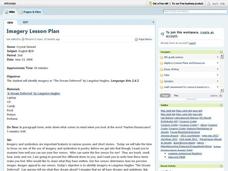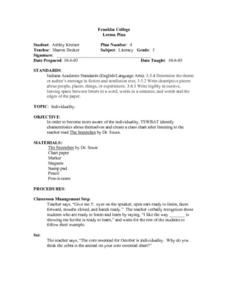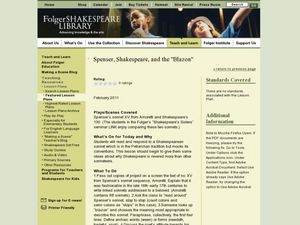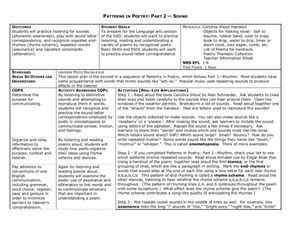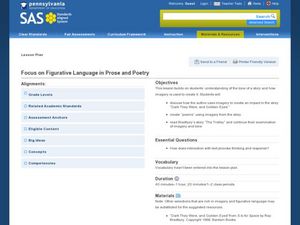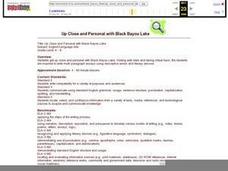Maryland Department of Education
The Concept of Identity Lesson 2: The Historical/Biographical Approach
"How does our environment shape our identity?" After researching biographical information about John Knowles and considering how these experiences are reflected in A Separate Peace, class members consider the strengths and weaknesses of...
Maryland Department of Education
The Concept of Identity Lesson 4: The Psychological Approach
Readers apply Sigmund Freud's theories of the unconscious mind and the psychological approach to literary criticism to analyze and evaluate the relationship between two characters in A Separate Peace.
Curated OER
Hearing the Poetry of Langston Hughes Through the Sounds of Jazz
Students have an appreciation of Langston Hughe's poetry and his use of jazz rhythms, have the ability to read poetry closely, and freewrite to gain a fresh perspective on music and literature.
Curated OER
Henry Wadsworth Longfellow's "Haunted Houses"
Learners read and analyze Henry Wadsworth Longfellow's poem, "Haunted Houses." They define key vocabulary terms, discuss the poem's technical aspects, and create an original poem about a haunted house or a haunted place.
Curated OER
The Pledge of Allegiance
Young scholars explore U.S. history by identifying American symbolism. In this American Flag instructional activity, students read the poem "The Flag" by M. Hubbard and define the symbolism of the colors and stripes within the U.S. flag....
Curated OER
Imagery Lesson Plan
Learners are introduced to the term imagery. Individually, they read "The Dream Deferred" and note examples of imagery in the poem. To end the lesson, they write their own poem making sure to use the five components of imagery.
Curated OER
Language Arts: What Makes an Individual
Third graders listen to the teacher read "The Sneetches" prior to creating charts about their individual characteristics. After numerous examples of individuality, they compile them on chart paper. As an extension, 3rd graders write...
Curated OER
You Too Can Haiku: How to Write a Haiku
Learners explore language arts by writing their own poems. In this haiku lesson, students investigate the Japanese culture and their beautiful music, poetry and art. Learners count the syllables in every line of a haiku poem and write...
Read Works
The Tone of a Poem
Tone and poetry are closely tied. Show your class how to determine the tone of a poem by noting your reactions and marking lines that bring out feelings. Next, work as a class to work through a second poem. Finally, have individuals read...
Curated OER
Frederick
First graders listen to a read aloud of Leo Lionni's, Frederick, and illustrate a scene from the story.
Curated OER
Spenser, Shakespeare, and the "Blazon": Lesson 4
Students discuss the meaning and tone of Shakespeare's Sonnet 130. In this sonnets lesson, students compare Spenser's sonnets to Shakespeare's. Students discuss specific words that add to the humor in Shakespeare's sonnet,...
Curated OER
Where in the World is Flat Stanley?
Second graders analyze the proper form of a friendly letter and send flat Stanley letters all over the United States. In this letter writing lesson, 2nd graders read the book Flat Stanley by Jeff Brown and create their own Flat...
Curated OER
Rain
First graders practice oral and silent reading using beginning comprehension and decoding strategies. In this guided reading instructional activity, 1st graders take a picture walk and make plot predictions prior to reading the...
Curated OER
Bridge to Terabithia: Visualizing to Optimize Comprehension
Good readers visualize. And in our image-rich culture it is imperative that children are provided with opportunities to practice this important skill. A selection from Shel Silverstein’s Where the Sidewalk Ends and Bridge to Terabithia,...
Curated OER
Thanksgving Poem
First graders read a Thanksgiving poem to build reading comprehension skills. They develop the skill of using context clues while explaining the meaning of each line of the poem. The assessment is done as the teacher listens to poems...
Curated OER
Valerie Bloom Poetry
Students listen to Granny Is, a poem by Valerie Bloom and discuss the metaphors in the poem. In this poetry lesson, students read poetry written by Valerie Bloom and discuss the techniques she uses. Students write grandmother poems.
Curated OER
Patterns in Poetry: Part 2 -- Sound
Learners understand a variety of poems listening for sound letter correspondence, rhyme scheme, assonance, and alliteration. In this language arts instructional activity, students practice listening and reading skills to complete...
Curated OER
Reading Poems Aloud: Sound And Meaning
Learners consider the elements involved in reading poetry aloud. They discuss different poetic forms and how the choices a reader makes in tone, emphasis, breaths, and pauses can affect the listener's interpretation and understanding of...
Curated OER
The Elements of Poetry
Ninth graders explore the elements in poetry. In groups, they complete a jigsaw puzzle and discover the strategies for completing a puzzle and reading a poem are similar. Students read short poems and identify key elements in a poem...
Curated OER
Focus on Figurative Language in Prose and Poetry
Students place emphasis on the use of figurative language when analyzing prose and poetry. In this figurative language lesson, students explore the tone of a story and its imagery. Students read and discuss how the author uses imagery in...
Curated OER
Poetry and PowerPoint
Third graders read and discuss the poem, "April Rain Song" by Langston Hughes. After brainstorming examples of vivid verbs, figures of speech, language patterns, and imagery used in the poem, 3rd graders write a poem on a topic of...
Curated OER
Up Close and Personal with Black Bayou Lake
Students get up close and personal with Black Bayou Lake. Visiting web sites and taking virtual tours, they write multi-paragraph essays using descriptive words and literary devices.
Curated OER
An Interdisciplinary Approach to Learning with Walt Whitman
Use poetry as a mode for creating interest and cross discipline learning.
Curated OER
Analyzing Poetic Devices: Robert Hayden's "Those Winter Sundays" and Theodore Roethke's "My Papa's Waltz"
Students examine how Robert Hayden and Theodore Roethke incorporate poetic devices to convey meaning in the poems, 'Those Winter Sundays,' and 'My Papa's Waltz.' They listen to audio clips, explore websites, and write an analysis of the...







